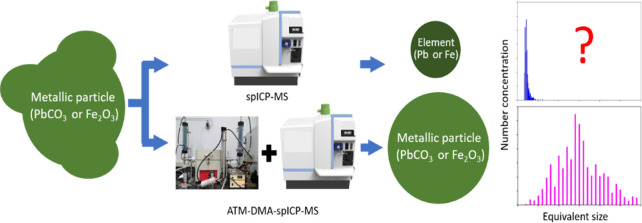- Record: found
- Abstract: found
- Article: found
Characterization of Fe-Containing and Pb-Containing Nanoparticles Resulting from Corrosion of Plumbing Materials in Tap Water Using a Hyphenated ATM-DMA-spICP-MS System

Read this article at
Abstract

Single-particle inductively coupled plasma mass spectrometry (spICP-MS) has been used to characterize metallic nanoparticles (NPs) assuming that all NPs are spherical and composed of pure element. However, environmental NPs generally do not meet these criteria, suggesting that spICP-MS may underestimate their true sizes. This study employed a system hyphenating the atomizer (ATM), differential mobility analyzer (DMA), and spICP-MS to characterize metallic NPs in tap water. Its performance was validated by using reference Au nanoparticles (AuNPs) and Ag-shelled AuNPs. The hyphenated system can determine the actual size and metal composition of both NPs with additional heating after ATM, while stand-alone spICP-MS misidentified the Ag-shelled AuNPs as smaller individual AgNPs and AuNPs. Dissolved metal ions could introduce artifact NPs after heating but could be eliminated by centrifugation. The hyphenated system was applied to characterize Fe-containing and Pb-containing NPs resulting from the corrosion of plumbing materials in tap water. The mode sizes of Fe-containing and Pb-containing NPs were determined to be 110 and 100 nm and the particle number concentrations were determined to be 4.99 × 10 7 and 1.40 × 10 6 #/mL, respectively. Cautions should be paid to potential changes in particle size induced by heating for metallic NPs with a low melting point or a high organic content.
Abstract
The sizes and concentrations of Fe-containing and Pb-containing nanoparticles in tap water resulting from the corrosion of plumbing materials can be determined using the hyphenated ATM-DMA-spICP-MS system.
Related collections
Most cited references50
- Record: found
- Abstract: not found
- Article: not found
Nanoparticles: Properties, applications and toxicities
- Record: found
- Abstract: found
- Article: not found
Characterization techniques for nanoparticles: comparison and complementarity upon studying nanoparticle properties
- Record: found
- Abstract: found
- Article: not found